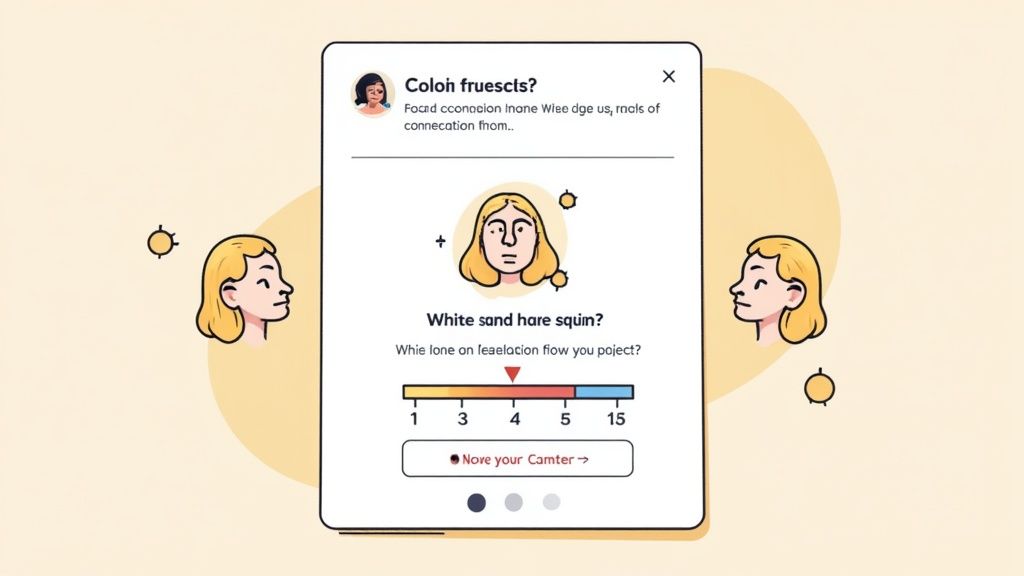February 18, 2025
10 Customer Service Performance Metrics You Should Be Tracking
Unlocking Customer Service Excellence: The Power of Metrics
Great customer service is essential for business growth and success. Companies need clear ways to measure and improve their service quality to build strong customer relationships and drive revenue. The key is understanding and applying the right performance metrics.
Customer service measurement has evolved significantly over time. What started as basic call logging has grown into sophisticated performance analytics. Modern approaches focus on predicting customer needs and optimizing the entire customer journey, not just resolving immediate issues. Effective measurement involves analyzing trends, finding root causes, and using data to help teams deliver consistently excellent service.
Success depends on choosing metrics that matter. The best approach uses a balanced scorecard with metrics for both operational efficiency and customer experience quality. These key performance indicators provide crucial insights into customer satisfaction, agent performance, and overall service effectiveness.
In this guide, we'll explore 10 essential customer service metrics that businesses of all sizes should track. You'll learn how to select the most relevant metrics for your specific goals and use them to enhance customer service operations, increase satisfaction, and achieve measurable business results.
1. Customer Satisfaction Score (CSAT)

The Customer Satisfaction Score (CSAT) helps businesses understand how happy customers are with specific interactions, products, or services. This key metric uses a simple 1-5 scale survey question, where 1 means "very dissatisfied" and 5 means "very satisfied", to measure customer feedback.
Understanding CSAT and Its Application:
CSAT works best when used right after customer interactions – like purchases, support calls, or website visits. This quick feedback lets companies spot and fix problems fast, before they become bigger issues. The direct nature of CSAT makes it valuable for tracking customer experience over time.
Background and Growth:
While satisfaction surveys have existed for many years, CSAT has become essential as businesses focus more on customer experience. Tools from companies like Zendesk and Qualtrics have made it simple to collect and analyze CSAT data, helping establish it as a core business metric.
Key Characteristics:
- Clear Rating System: Uses an easy-to-understand 1-5 scale that customers quickly grasp
- Quick Implementation: Setting up CSAT surveys requires minimal technical work
- Real-Time Insights: Gets immediate feedback after customer interactions
- Measurable Results: Provides concrete data to track improvements
Advantages:
- Straightforward Customer Input: Shows exactly how customers feel
- Simple Progress Tracking: Easy to monitor changes in satisfaction over time
- Strong Response Rates: Brief surveys encourage more customers to give feedback
- Industry Benchmarking: Compare scores against competitors and standards
Limitations:
- Potential Response Bias: Cultural differences and survey design can affect results
- Surface-Level Feedback: May miss deeper reasons behind customer opinions
- Short-Term Focus: Measures immediate satisfaction rather than long-term loyalty
Real-World Examples:
- Amazon sends satisfaction surveys after purchases to evaluate products and delivery
- Zendesk includes CSAT tools in their platform for easy feedback collection
- Apple uses CSAT to assess customer reactions to products and support
Implementation Tips:
- Keep surveys brief: Use just 1-2 key questions
- Time surveys well: Ask for feedback while experience is fresh
- Use standard scales: Maintain consistent rating systems
- Act on negative scores: Follow up quickly on poor ratings
When used effectively, CSAT helps companies understand customer needs, find areas to improve, and create better experiences that keep customers coming back.
2. Net Promoter Score (NPS)
Net Promoter Score (NPS) measures how likely customers are to recommend a company's products or services to others. This widely used metric helps predict business growth by measuring customer loyalty in a simple, standardized way.
How NPS Works:
NPS is based on a straightforward question: "On a scale of 0 to 10, how likely are you to recommend [company name] to a friend or colleague?" The responses place customers into three categories:
- Promoters (9-10): These loyal customers actively recommend your brand
- Passives (7-8): Content but not enthusiastic customers who could switch to competitors
- Detractors (0-6): Unhappy customers who may discourage others
Your NPS is calculated by subtracting the percentage of Detractors from Promoters, giving a score between -100 and +100.
Key Features:
- Simple Rating Scale: Easy-to-understand 0-10 scoring system
- Clear Customer Groups: Segments users for targeted follow-up
- Quick Single Question: High response rates due to simplicity
- Rich Feedback: Follow-up questions provide context behind scores
Benefits:
- Growth Indicator: Higher scores correlate with increased revenue
- Industry Comparisons: Benchmark against competitors
- Easy Implementation: Simple to set up and analyze
- Universal Standard: Widely used across many industries
Limitations:
- Simplified View: May miss nuances in customer relationships
- Regional Differences: Scoring patterns vary between cultures
- Basic Insights: Score alone doesn't show specific improvement areas
Success Stories:
- Apple: Maintains high NPS through strong brand experience
- Tesla: Uses scores to guide product improvements
- Netflix: Tracks NPS to understand subscriber satisfaction
Implementation Tips:
- Regular Tracking: Monitor scores consistently over time
- Focus on Trends: Watch for changes rather than absolute numbers
- Get Detailed Feedback: Always ask why customers gave their score
- Quick Response: Address concerns promptly when identified
Background:
Fred Reichheld of Bain & Company introduced NPS in his 2003 Harvard Business Review article "The One Number You Need to Grow." It has since become a key metric for measuring customer satisfaction and loyalty across industries.
When used properly, NPS helps companies understand customer sentiment, identify problems, and make smart improvements to grow their business.
3. First Response Time (FRT)
First Response Time (FRT) measures how quickly your team provides an initial reply to customer inquiries or support tickets. While this doesn't mean resolving the issue completely, it shows customers their request has been received and is being worked on. This basic acknowledgment sets a positive tone and helps build trust with customers from the start.
The rise of email and chat support has made FRT even more important. Modern customers want faster responses compared to traditional phone support. This trend has been supported by help desk platforms that can now track and measure FRT automatically.
Key Features:
- Clear measurement: FRT provides specific, measurable data for performance tracking
- Channel monitoring: Track response times across email, phone, chat and social media
- Built-in analytics: Most support platforms calculate FRT automatically
- Live tracking: Real-time dashboards help teams adjust staffing and workload
Advantages:
- Higher satisfaction: Quick responses create happier customers
- Simple to track: FRT is straightforward to measure and monitor
- Clear insights: Shows how responsive your team really is
- Better planning: FRT patterns reveal when you need more staff
Challenges:
- Quality vs speed: Fast but unhelpful responses can frustrate customers
- Rushing responses: Teams may prioritize speed over thorough answers
- Different expectations: Response time goals vary by channel and issue complexity
Company Examples:
- HubSpot: Provides 24/7 support with an emphasis on quick response times across channels
- Shopify: Known for rapid chat support that helps merchants get answers quickly
- Intercom: Offers built-in FRT tracking to help businesses improve their response times
Tips for Success:
- Set channel goals: Create realistic FRT targets for each support channel – aim for 1 hour on email and under 1 minute for chat
- Use auto-replies: Send automated acknowledgments during busy periods
- Focus on quality: Train agents to balance speed with helpful, accurate responses
- Plan coverage: Adjust staffing across time zones to maintain consistent response times
FRT remains a vital metric because it directly shows how quickly your team engages with customers who need help. Regular monitoring and optimization of your FRT helps create better customer experiences and stronger relationships. The key is finding the right balance between fast responses and quality support.
4. Resolution Rate
Resolution Rate is a crucial metric that shows the percentage of customer issues fixed on the first try without needing escalation. When customers get their problems solved immediately, it leads to happier users and lower costs. That's why Resolution Rate is essential for evaluating support team performance.
The core focus is getting it right the first time. This goes beyond simply marking tickets as closed – it measures whether the issue was truly resolved. If a customer has to contact support again about the same problem, any efficiency gains are lost.
Contact centers started tracking Resolution Rate as they needed clear ways to measure and improve their service quality. Being able to solve problems quickly and completely became a key way for companies to stand out.
Key Capabilities:
- Efficiency tracking: Identifies bottlenecks and areas needing improvement
- Repeat contact monitoring: Higher resolution rates mean fewer repeat contacts
- Escalation patterns: Shows which issues often need escalation, pointing to knowledge gaps
- Resolution timing: While speed isn't everything, better resolution rates often mean faster solutions
Benefits:
- Shows team effectiveness: High rates indicate good processes and training
- Improves satisfaction: Quick, complete solutions make customers happy
- Reveals training needs: Low rates highlight areas where agents need help
- Reduces costs: Fewer follow-ups mean lower expenses
Challenges:
- Quality vs quantity: Agents might rush to boost numbers instead of solving thoroughly
- Clear definitions needed: Without specific standards, measuring becomes subjective
- Complex issues take time: Some problems naturally need multiple contacts and shouldn't count against performance
Real Examples:
- Microsoft Xbox support and American Express service teams use resolution rate as a key metric, seeing direct links to customer loyalty
- Google Cloud prioritizes resolution rate since technical issues can seriously impact business customers
Implementation Tips:
- Set clear standards: Define exactly what "resolved" means – for example, the customer confirms the fix and doesn't return within 72 hours
- Track repeat contacts: Check how often customers come back with the same issue to verify resolution quality
- Train thoroughly: Give agents the knowledge and tools to solve problems right away
- Build knowledge base: Maintain clear documentation so both agents and customers can find answers quickly
By tracking Resolution Rate and following these guidelines, companies can deliver better service while keeping costs under control. This creates a better experience for both customers and support teams.
5. Customer Effort Score (CES)
Customer Effort Score (CES) measures how easy or difficult it is for customers to accomplish their goals when interacting with your company. Research shows that making things easy for customers directly impacts their loyalty and future purchases. When customers can effortlessly do business with you, they're more likely to come back.
How CES Works:
The measurement uses a 1-7 scale, asking customers questions like "How much effort did you personally have to put forth to handle your request?" A score of 1 means very low effort, while 7 indicates very high effort. Unlike broader metrics like NPS that capture overall sentiment, CES focuses specifically on ease of use. Companies typically collect CES feedback right after specific interactions to understand particular touchpoints.
Why CES Matters:
Research from Gartner found that customers who had low-effort experiences were significantly more likely to buy again, spend more money, and recommend the company to others. High-effort experiences had the opposite effect – driving customers away and hurting brand reputation.
Benefits of Using CES:
- Predicts future behavior: CES effectively forecasts whether customers will stay loyal
- Spots problem areas: Measuring effort at key touchpoints reveals where customers struggle
- Guides improvements: CES data shows exactly what needs to be fixed
- Tracks progress: Regular CES monitoring shows if changes are making things easier
Limitations of CES:
- Limited history: As a newer metric, there's less benchmark data compared to CSAT and NPS
- Misses emotional aspects: CES may not capture how customers feel about their experience
- Needs additional context: Low scores often require more investigation to understand root causes
Real-World Examples:
- Amazon's one-click ordering: Removes friction from the purchase process
- Uber's user flow: Seamlessly connects riders with drivers from request to payment
- Slack's interface: Makes team communication simple and intuitive
Tips for Using CES:
- Reduce steps: Remove unnecessary friction points and empower quick issue resolution
- Check all channels: Monitor effort across phone, email, chat and social support
- Fix high-effort areas: Focus on improving the most difficult touchpoints first
- Compare performance: Look for relevant industry benchmarks to assess your scores
The Value of CES:
Customers expect smooth, effortless experiences. CES helps businesses identify and fix friction points that frustrate customers. By consistently measuring and improving customer effort, companies can strengthen relationships and increase customer loyalty.
6. Average Handle Time (AHT)
Average Handle Time (AHT) measures how long it takes to fully resolve a customer interaction, including talk time, hold time, and any follow-up work needed. This key metric helps contact centers track efficiency across different channels like phone, email and chat.
AHT directly impacts operational costs and productivity. Getting clear data on interaction durations helps managers optimize staffing levels, identify training needs, and improve processes.
Features and Benefits:
- Total interaction time: Tracks the complete customer journey from first contact to resolution
- Multi-channel measurement: Analyzes performance across phone, email, chat and other channels
- Performance benchmarking: Provides data to evaluate agent and team efficiency
- Resource planning: Helps forecast staffing needs based on contact volumes
- Cost optimization: Enables smarter allocation of staff and resources
- Training insights: Shows where agents need additional support
Pros:
- Clear performance data: Provides specific metrics on agent and team efficiency
- Better forecasting: Enables more accurate resource planning
- Cost control: Identifies areas to improve efficiency and reduce costs
- Training focus: Pinpoints specific skill gaps that need development
Cons:
- Quality risk: Too much focus on speed can hurt service quality
- Variable complexity: Complex issues naturally take longer to resolve
- Agent stress: Excessive time pressure can lead to burnout
Real-World Examples:
Major companies like Verizon, Bank of America, and British Airways use AHT to track performance in their contact centers. For example, banks analyze handle times for different types of inquiries to find process improvements.
Evolution and Growth:
AHT became essential as contact centers grew and needed to optimize costs. Modern call center platforms make it easier to track and analyze this data for actionable insights.
Implementation Tips:
- Balance speed and quality: Don't sacrifice good service just to lower handle times
- Categorize contacts: Group similar inquiries together for meaningful comparisons
- Improve processes: Give agents efficient tools and workflows
- Train thoroughly: Ensure agents have the knowledge to resolve issues quickly
By tracking AHT while maintaining service standards, contact centers can optimize operations while keeping customers satisfied.
7. Customer Retention Rate
Customer Retention Rate (CRR) shows what percentage of customers stay with your business over time. It's essential for success since keeping existing customers costs far less than finding new ones. A high CRR is directly linked to better profits and stable long-term growth.
This metric reveals how well you're meeting customer needs and building lasting relationships. By tracking CRR, companies can see how their customer service affects revenue and find ways to prevent customer loss. Rather than quick wins, CRR focuses on enduring success.
Key Benefits:
- Clear view of growth trends beyond simple sales numbers
- Shows customer satisfaction and loyalty levels
- Links directly to recurring revenue and reduces acquisition costs
- Helps prevent customer loss by spotting issues early
Real Examples:
Look at subscription businesses like Netflix – they carefully monitor subscriber retention since it directly affects their bottom line. Adobe Creative Cloud's success depends heavily on keeping subscribers. Even companies like Salesforce that aren't purely subscription-based make retention a top priority. Netflix, for instance, uses data analysis to suggest personalized content, which helps keep subscribers engaged.
How It's Changed:
While keeping customers has always mattered, measuring and acting on retention data has become more precise. As subscription services grow and data analysis improves, CRR has become crucial. Companies now understand that focusing on customer lifetime value, which connects closely to retention, is vital for lasting success.
Advantages:
- Direct profit impact: Higher retention means more revenue
- Shows business health: Good retention indicates a stable model
- Cost-effective: Keeping customers costs less than finding new ones
- Guides planning: Retention data helps shape service and product decisions
Challenges:
- Shows past results: May not reflect current issues quickly
- Many factors involved: Customer loss can have multiple causes
- Varies by industry: Hard to compare across different business types
Practical Steps:
- Look at customer groups: Different segments need different approaches
- Find at-risk customers: Take action before they leave
- Create loyalty programs: Reward loyal customers with special offers
- Stay in touch: Regular communication builds stronger connections
By actively managing your Customer Retention Rate, you can build lasting growth, increase profits, and develop a loyal customer base. This metric matters for any business aiming for long-term success.
8. Ticket Volume Trends
Keeping track of support ticket patterns helps customer service teams work better and meet customer needs early. This involves analyzing how many tickets come in, what issues customers report, and how often certain problems occur. Looking at these patterns gives businesses key insights into customer behavior and shows how well their support team is performing.
Key elements of ticket volume analysis include:
- Daily Tracking: Monitor total tickets received across different time periods (day/week/month/year). Watch for sudden increases that might signal problems.
- Issue Types: Group tickets into clear categories like "billing," "technical issues," "product problems," or "feature requests" to spot common issues.
- Historical Patterns: Look at past ticket data to find recurring problems, like increased reports after new releases.
- Seasonal Changes: Plan for predictable busy periods around holidays or industry events to staff appropriately.
Why This Data Matters:
Support ticket patterns reveal both how well customer service works and potential product issues. Beyond just counting tickets, understanding the reasons behind them helps predict staffing needs, find systemic problems, and allocate resources wisely. Teams can get ahead of issues before they affect more customers.
Real Company Examples:
- Spotify: Uses ticket analysis to find issues affecting specific user groups or regions, helping them fix bugs faster and improve help content.
- PayPal: Tracks transaction problems to catch fraud early and keep payments secure.
- Discord: With its large user base, analyzes tickets to maintain stable servers and improve moderation.
Benefits:
- Better staff planning and scheduling
- Early problem detection
- Improved resource allocation
- Prevention of future issues
Challenges:
- Needs consistent ticket labeling
- May miss issue complexity
- External factors can affect numbers
Implementation Tips:
- Create Clear Categories: Use a well-defined system to label tickets accurately
- Track Seasonal Changes: Note busy periods tied to holidays or industry events
- Find Root Causes: Look beyond symptoms to underlying problems
- Take Preventive Steps: Use insights to stop issues before they start
By tracking support patterns carefully, companies can shift from reactive to proactive customer service, working more efficiently while improving the customer experience.
9. Quality Assurance Score
Quality Assurance (QA) scoring helps companies measure how well customer service teams meet established quality standards. By evaluating real customer interactions, QA scores provide insights into agent performance and help improve service delivery.
Key Elements of QA Evaluations
QA specialists review customer interactions across channels like phone, email and chat. They assess each interaction using standardized criteria including:
- Knowledge: Understanding of products/services
- Communication: Clarity and professionalism
- Customer Connection: Building rapport and showing empathy
- Issue Resolution: Effectively solving problems
- Process Compliance: Following required procedures
Essential Components of QA Programs:
- Clear evaluation criteria that ensure fair and consistent scoring
- Regular monitoring to track performance trends over time
- Specific feedback to help agents improve
- Targeted training based on QA findings
History and Development
QA programs evolved alongside contact centers, initially focusing mainly on script compliance. As customer experience became more important, evaluation criteria expanded to include soft skills like empathy and problem-solving ability. Modern QA programs now use AI tools to help analyze interactions and identify patterns.
Examples From Leading Companies:
- American Airlines evaluates agents on brand standards and regulatory compliance
- T-Mobile focuses QA on problem resolution and customer experience
- Amazon maintains strict QA standards across its large service operation
Key Benefits:
- Creates consistent service quality
- Identifies specific training needs
- Drives performance improvements
- Ensures quality control and compliance
Common Challenges:
- Some evaluation elements remain subjective
- Manual reviews take significant time
- May increase agent stress levels
Implementation Tips:
- Create clear scoring criteria tied to business goals
- Hold regular calibration sessions with evaluators
- Deliver constructive, growth-focused feedback
- Connect findings directly to training programs
A well-designed QA program helps organizations deliver better customer service, improve satisfaction, and achieve business objectives through ongoing measurement and coaching.
10. Customer Lifetime Value (CLV)
Customer Lifetime Value (CLV) is a key metric that shows how much total revenue a business can expect from a single customer over their entire relationship. CLV helps companies make smart choices about sales, marketing, customer service, and product development by looking beyond one-time purchases to see the full value each customer brings.
With the growth of subscription services and focus on keeping existing customers, CLV has become essential for business success. While companies used to chase new customers at any price, research shows that keeping current customers costs less and brings more profit. CLV helps calculate the real cost and potential return of acquiring customers.
Key Elements of CLV:
- Extended revenue view: Considers income beyond the first purchase
- Profit measurement: Shows how much each customer generates
- Relationship tracking: Accounts for how long customers stay
- ROI indicator: Evaluates returns on customer acquisition spending
Benefits of Using CLV:
- Better planning: Enables data-based decisions
- Investment clarity: Shows value of customer programs
- Smart targeting: Identifies top customers for campaigns
- Resource focus: Helps spend money where it matters most
Challenges with CLV:
- Hard to calculate: Many factors affect customer behavior
- Needs data history: Requires past purchase records
- Future uncertainty: Customer habits can change
Real Examples:
- Starbucks Rewards: Drives repeat visits and loyalty
- Amazon Prime: Creates steady income and engagement
- Apple ecosystem: Keeps customers using multiple products
Implementation Tips:
- Group customers: Cluster similar customers for better predictions
- Include all costs: Factor in service and acquisition expenses
- Watch relationships: Track how long customers stay active
- Study buying habits: Look for patterns to predict future sales
CLV is a vital metric because it shows the real worth of customer relationships over time. For call centers, CLV guides staffing and retention efforts. Customer service teams use it to focus on high-value clients. Sales teams target profitable customers more effectively. Business analysts measure marketing success. Quality managers spot areas to improve customer experience. Understanding CLV helps build lasting customer relationships and boost long-term profits.
10-Point Customer Service Performance Comparison
| Method | Difficulty | Time Required | Results | Best For | Key Benefit |
|---|---|---|---|---|---|
| Customer Satisfaction Score (CSAT) | Low 🔄 | Quick ⚡ | Quantifiable 📊 | Instant customer feedback | High effectiveness ⭐ |
| Net Promoter Score (NPS) | Low 🔄 | Quick ⚡ | Benchmarkable 📊 | Customer loyalty tracking | Growth prediction ⭐ |
| First Response Time (FRT) | Low 🔄 | Real-time ⚡ | Performance clarity 📊 | Support responsiveness | Satisfaction boost ⭐ |
| Resolution Rate | Moderate 🔄 | Variable ⚡ | Efficiency indicator 📊 | Support optimization | Issue resolution improvement ⭐ |
| Customer Effort Score (CES) | Moderate 🔄 | Moderate ⚡ | Actionable insights 📊 | Ease of service evaluation | Loyalty enhancement ⭐ |
| Average Handle Time (AHT) | Moderate 🔄 | Time-intensive ⚡ | Efficiency tracking 📊 | Resource planning | Cost management ⭐ |
| Customer Retention Rate | Moderate 🔄 | Long-term ⚡ | Strategic insights 📊 | Loyalty & revenue tracking | Business impact ⭐ |
| Ticket Volume Trends | Moderate 🔄 | Ongoing ⚡ | Pattern recognition 📊 | Staffing and planning | Issue prediction ⭐ |
| Quality Assurance Score | High 🔄 | Routine ⚡ | Quality insights 📊 | Service consistency | Training improvement ⭐ |
| Customer Lifetime Value (CLV) | High 🔄 | Long-term ⚡ | Predictive revenue 📊 | Strategic planning | Resource allocation ⭐ |
Elevating Your Customer Service with Data-Driven Insights
Effectively measuring and analyzing these 10 customer service performance metrics gives businesses clear visibility into what's working and what needs improvement. The combination of CSAT, NPS, Customer Lifetime Value, and Quality Assurance Scores provides invaluable information to make smart decisions and deliver better service. The goal isn't just collecting data – it's using those insights to build lasting customer relationships.
Success requires discipline in monitoring performance and taking action. Set clear benchmarks for each metric, review results regularly against those targets, and make specific improvements where needed. For instance, if response times are slow, consider adding chat support or adjusting staff schedules. When customer effort scores indicate friction, examine the full customer journey to find and fix pain points.
Stay flexible and keep evolving your approach. Review your metrics periodically to ensure they still align with business objectives. As customer preferences and industry practices change, you may need to track different indicators or add new measurement tools. Watch for emerging trends like AI solutions and personalized service that could help optimize your customer interactions.
Key Takeaways:
- Data is King: Let metrics guide your decisions and improvements, not just track performance
- Customer-Centricity: Focus on satisfaction and building strong relationships
- Continuous Improvement: Regularly assess and update your strategies based on results
- Actionable Insights: Turn data into concrete steps that enhance processes and outcomes
Take your customer service to the next level with Call Criteria. Our blend of AI technology and human expertise provides the detailed insights needed to improve agent performance, increase satisfaction, and drive better business results. We help you identify improvement opportunities, enhance training, and maintain consistent quality in every interaction. Visit us today to learn how we can help you deliver outstanding customer service.









